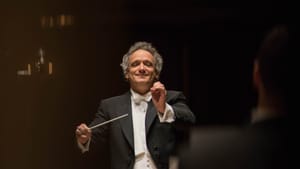Stay in the Loop
BSR publishes on a weekly schedule, with an email newsletter every Wednesday and Thursday morning. There’s no paywall, and subscribing is always free.
Beethoven, and Brahms, and Schnittke, oh my!
The Philadelphia Orchestra with Louis Langrée and Midori

Matinee audiences, white of hair and lured by Brahms, are not always intrigued by Alfred Schnittke, the Soviet-German composer known for an adventurous mashup of styles and the bleak landscapes of his later compositions. But in Moz-Art a la Haydn, a 15-minute romp for strings, he soon had audience members smiling as familiar passages from the classical masters parried with flashes of the composer’s own ingenuity.
Dawn to dusk
The work starts in the dark, literally, with strings softly chirping like peepers in an early spring marsh. That’s an homage to Haydn’s The Creation. As light dawns on the stage, a dozen or so string performers launch into an imaginative aural feast, with “Schnittke’s snippets” from such Mozart favorites as the Haffner Symphony, "Ave Verum Corpus," and the 40th Symphony. To the right and left of guest conductor Louis Langrée, are first associate concertmaster Juliette Kang and principal second violin Kimberly Fisher, performing their solo roles with wit, masterful musicianship, and the presence of mind to glide gracefully across the stage without skipping a beat.
The work ends a la Haydn, whose Farewell Symphony has the performers gradually exiting the stage as the work dwindles to the refrain of a single violin. In this case, shadows fall once again, and maestro Langrée is left lifting a silent baton in the dark. Very well done, musically, theatrically, and choreographically.
I was impressed by Langrée’s conducting throughout this concert, which also featured the Beethoven Violin Concerto with Midori, and the second in the series of all four Brahms symphonies. The French conductor is music director of the Mostly Mozart Festival at Lincoln Center in New York and of the Cincinnati Symphony Orchestra.
A welcome return
Midori made her first appearance with the Philadelphia Orchestra when she was still a child prodigy, and it is heartening to see her artistry continue to develop and gain new admirers as she approaches middle age. In the concerto, Langrée managed the large forces of the orchestra superbly in one of the most iconic works of Beethoven’s heroic period.
I think there is a tendency to under-emote with this work, which is a real powerhouse of passion and revolutionary spirit. In the first and third movement, this spirit was in full display, except deliberately, during the elegant but gentle tones of the soloist’s Guarneri violin. Midori’s virtuosity, tenderness, and dexterity were just about flawless, but could be easily obscured by the volume of a full orchestra.
Langrée managed this situation by reining in the orchestra as soon as the soloist’s bow touched the strings. The orchestra maintained a seething, driven presence, filled with fire and aspiration, behind the buttery tones of Midori’s bel canto playing, giving us a richly complex yet satisfying musical experience.
Picking up the pace

The second movement was slow. Today, Beethoven scholars argue for a quicker pace for this section. Beethoven is my favorite composer (my novel about Beethoven, The Black Spaniard, is released this month), but even I nearly fell asleep during this rendition. Yet this is a matter of taste, not an imperative. For many, a lingering oasis of sound may be welcome after the spirited initial movement that lasts half an hour. In the first and final movements, Midori met the challenge of Fritz Kreisler’s cadenzas with elegance and insight, attacking one treacherous high note near the end with assertive flair.
By the time we got to the Brahms Second Symphony that closed the program, Langrée was warmed up and ready to go. This work is more relaxed and fluid than the towering first, and also more accessible, despite the restless energy that never lets up, even in the Adagio. In this work, Brahms shows us what a master of surprise he is. Something unexpected awaits at every turn, right up to the controlled hysteria of the last phrases of the final movement. I am so looking forward to hearing a broadcast of one of the three performances of this program on WRTI-FM on a future Sunday.
Langrée has captured it all with one of the world’s great orchestras, in peak form. Clearly, you can be emotional and expressive without being maudlin, you can be eager and energetic without being sloppy, you can be grand and uplifting without being pompous. You just have to be Louis Langrée with the Philadelphia Orchestra.
What, When, Where
The Philadelphia Orchestra. Louis Langrée, conductor. Midori, violin. Schnittke, Moz-Art a la Haydn; Beethoven, Violin Concerto in D major, Op. 61; Brahms, Symphony No. 2 in D major, Op. 73. November 3-5, 2016 at the Kimmel Center, Verizon Hall, 300 S. Broad St., Philadelphia. (215) 893-1999 or philorch.org.
Sign up for our newsletter
All of the week's new articles, all in one place. Sign up for the free weekly BSR newsletters, and don't miss a conversation.
 Linda Holt
Linda Holt